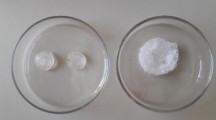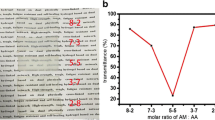Abstract
To find out the best structure of acrylamide-based hydrogels, three different composites are synthesized and characterized. Polyacrylamide-based hydrogels were obtained by chemical crosslinking of MBA using acrylamide, sodium carboxymethylecellulose (NaCMC), N,N,N′,N′-tetramethylethylenediamine (TEMED) and ammonium persulfate (APS) as the initiators. The interest in MgO nanoparticles is not only due to their stability under harsh process conditions but also for human health, where they are known to be necessary minerals. It is expected that the structure of the hydrogels can be affected positively by using MgO as a nanoparticle in their composite. To control the initial burst release through modification of the structure of the matrix, the MgO nanoparticles are applied. These nanoparticles can affect the release mechanism. In the current research, FESEM, NMR, DTA/TGA and DSC are studied for the structure of polymers. In the FESEM, existing MgO inside the hydrogel system brings about a shift in the porosity of hydrogels. The 1H NMR spectrum of polymers showed characteristic proton peaks at 4.6 and 4.7, 6.1 and 6.2 ppm. An endothermic peak indicating loss of weakly bound water molecules from the hydrogel network is shown in DTA curves of hydrogels at around 80 °C. An exothermic peak at around 270 °C for Aam and Aam/NaCMC hydrogels and also a peak at 360 °C in Aam and Aam/NaCMC hydrogels and 320 °C for Aam/NaCMC/MgO is shown. The DSC profiles of the hydrogels show that water has a higher evaporation temperature in the polyacrylamide hydrogel (84 °C).The largest depression of the temperature was observed on the Aam/NaCMC/MgO hydrogel (∆T = 94 °C), which confirmed the higher hydrophilicity of Aam/NaCMC/MgO as compared to pure Aam hydrogel and Aam/NaCMC hydrogel.





Similar content being viewed by others
Abbreviations
- FESEM:
-
Field emission scanning electron microscope
- NMR:
-
Nuclear magnetic resonance spectroscopy
- DTA:
-
Differential thermal analysis
- TGA:
-
Thermogravimetric analysis
- DSC:
-
Differential scanning calorimetry
- MgO:
-
Magnesium oxide
- Aam:
-
Acrylamide
- NaCMC:
-
Sodium carboxymethylcellulose
- FDA:
-
Food and drug administration
- BIS:
-
N,N′-Methylenebisacrylamide
- APS:
-
Ammonium persulfate
- AZAP:
-
Azobis (2-amidinopropane) HCl
- AZIP:
-
Azobis [2-(2-imidazolin-w-yl)propane]HCl
- TEMED:
-
Tetramethyl-ethylene diamine
- MMT:
-
Montmorillonite
- FTIR:
-
Fourier transform infrared spectroscopy
- 1HNMR:
-
Proton nuclear magnetic resonance
- CDCl3 :
-
Chloroform-d
- D2O:
-
Deuterium oxide
- IDT:
-
Initial decomposition temperature
- FDT:
-
Final decomposition temperature
- UCST:
-
Upper critical solution temperature.
References
C.C. Lin, A.T. Metters, Hydrogels in controlled release formulations: network design and mathematical modeling. Adv. Drug Deliv. Rev. 58, 1379–1408 (2006)
S. Chen, Y. Wu, F. Mi, Y. Lin, L. Yu, H. Sung, A novel pH-sensitive hydrogel composed of N, O-carboxymethyl chitosan and alginate cross-linked by genipin for protein drug delivery. J. Control. Release 96, 285–300 (2004)
S. Selvakumaran, I.I. Muhamad, S.I. Abd Razak, Evaluation of kappa carrageenan as potential carrier for floating drug delivery system: effect of pore forming agents. Carbohydr. Polym. 135, 207–214 (2016)
R.K. Malcolm, K. Edwards, P. Kiser, J. Romano, T.J. Smith, Advances in microbicide vaginal rings. Antiviral Res. 88, 30–39 (2010)
H. Karimi, F. Sabbagh, M. Eslami, H. Sheikhveisi, H. Samadyar, O. Talaee, Numerical modeling and calculation of sensing parameters of DNA sensors. In Advanced Bioelectronic Materials (Wiley, Hoboken, 2015), pp. 389–411
E. Karadag, D. Saraydin, S. Cetinkaya, O. Guven, In vitro swelling studies and preliminary biocompatibility evaluation of acrylamide-based hydrogels. Biomaterials 17, 67–70 (1996)
U. Griesenbach, C. Meng, R. Farley, M.Y. Wasowicz, F.M. Munkonge, M. Chan, C. Stoneham, S.G. Sumner-jones, I.A. Pringle, D.R. Gill, S.C. Hyde, B. Stevenson, E. Holder, H. Ban, M. Hasegawa, S.H. Cheng, R.K. Scheule, P.L. Sinn, P.B. Mccray, E.W.F.W. Alton, Biomaterials the use of carboxymethylcellulose gel to increase non-viral gene transfer in mouse airways. Biomaterials 31, 2665–2672 (2010)
J.A. Ludwig, J.N. Weinstein, Biomarkers in cancer staging, prognosis and treatment selection. Nat. Rev. 5, 845–856 (2005)
A.P. Rokhade, S.A. Agnihotri, S.A. Patil, N.N. Mallikarjuna, P.V. Kulkarni, T.M. Aminabhavi, Semi-interpenetrating polymer network microspheres of gelatin and sodium carboxymethyl cellulose for controlled release of ketorolac tromethamine. Carbohydr. Polym. 65, 243–252 (2006)
L. Liu, Reconstructing posterior distributions of a species phylogeny using estimated gene tree distributions (2006)
Y. Sudhakar, K. Kuotsu, A.K. Bandyopadhyay, Buccal bioadhesive drug delivery—a promising option for orally less efficient drugs. J. Control. Release 114, 15–40 (2006)
E. Karadaǧ, Ö.B. Üzüm, D. Saraydin, Water uptake in chemically crosslinked poly(acrylamide-co-crotonic acid) hydrogels. Mater. Des. 26, 265–270 (2005)
B. Chen, A. Chrambach, Estimation of polymerization efficiency in the formation of polyacrylamide gel, using continuous optical scanning during polymerization, J. Biochem. Biophys. Methods 2, 105–116 (1979)
A. Pourjavadi, H. Ghasemzadeh, R. Soleyman, Synthesis, characterization, and swelling behavior of alginate-g-poly (sodium acrylate)/kaolin superabsorbent hydrogel composites. J. Appl. Polym. Sci. 105, 2631–2639 (2007)
A. Pourjavadi, M. Ayyari, Taguchi optimized synthesis of collagen-g-poly (acrylic acid)/ kaolin composite superabsorbent hydrogel. Eur. Polym. J. 44, 1209–1216 (2008)
W. Wang, J. Wang, Y. Kang, A. Wang, Synthesis, swelling and responsive properties of a new composite hydrogel based on hydroxyethyl cellulose and medicinal stone. Compos. Part B 42, 809–818 (2011)
F. Sabbagh, I.I. Muhamad, Acrylamide-based hydrogel drug delivery systems: release of Acyclovir from MgO nanocompositehydrogel. J. Taiwan Inst. Chem. Eng. 72, 182–193 (2017)
H. Hezaveh, I.I. Muhamad, Impact of metal oxide nanoparticles on oral release properties of pH-sensitive hydrogel nanocomposites. Int. J. Biol. Macromol. 50, 1334–1340 (2012)
M.A. Janney, O.O. Omatete, C.A. Walls, S.D. Nunn, R.J. Ogle, Development of low-toxicity gelcasting systems. J. Am. Ceram. Soc. 91, 581–591 (1998)
K.T. Barnhart, E.S. Pretorius, K. Timbers, D. Shera, M. Shabbout, D. Malamud, Distribution of a 3.5-mL (1.0%) C31G vaginal gel using magnetic resonance imaging. Contraception 71, 357–361 (2005)
Y.A. Han, M. Singh, B.B. Saxena, Development of vaginal rings for sustained release of nonhormonal contraceptives and anti-HIV agents. Contraception 76, 132–138 (2007)
P.H.M. Van De Ronald Barentsen, J.H.N. Weijer, Schram, gynecolg continuous low dose estradiol released from a vaginal ring versus estriol vaginal cream for urogenital atrophy. Eur. J. Obstet. Gynecol. 71, 73–80 (1997)
A. Hentrich, Herstellung von polymeren Stents als Drug Delivery Systeme durch Tauchen aus der Polymerlösung. Univerlagtuberlin (2005)
R. Dash, M. Foston, A.J. Ragauskas, Improving the mechanical and thermal properties of gelatin hydrogels cross-linked by cellulose nanowhiskers. Carbohydr. Polym. 91, 638–645 (2013)
H.S. Samanta, S.K. Ray, Synthesis, characterization, swelling and drug release behavior of semi-interpenetrating network hydrogels of sodium alginate and polyacrylamide. Carbohydr. Polym. 99, 666–678 (2014)
N. Şahiner, S. Malci, Ö. Çelikbiçak, Ö. Kantǒlu, B. Salih, Radiation synthesis and characterization of new hydrogels based on acrylamide copolymers cross-linked with 1-allyl-2-thiourea. Radiat. Phys. Chem. 74, 76–85 (2005)
M.S. Rahman, G. Al-Saidi, N. Guizani, A. Abdullah, Development of state diagram of bovine gelatin by measuring thermal characteristics using differential scanning calorimetry (DSC) and cooling curve method. Thermochim. Acta 509(1), 111–119 (2010)
M.M. Ozmen, M.V. Dinu, O. Okay, Preparation of macroporous poly (acrylamide) hydrogels in DMSO/water mixture at subzero temperatures. Polym. Bull. 60(2), 169–180 (2008)
M.H. Kabir, T. Hazama, Y. Watanabe, J. Gong, K. Murase, T. Sunada, H. Furukawa, Smart hydrogel with shape memory for biomedical applications. J. Taiwan Inst. Chem. Eng. 45(6), 3134–3138 (2014)
F. Sabbagh, I.I. Muhamad, Production of poly-hydroxyalkanoate as secondary metabolite with main focus on sustainable energy. Renew. Sust. Energy Rev. 72, 95–104 (2017)
Y. Lu, P. Spyra, Y. Mei, M. Ballauff, A. Pich, Composite hydrogels: robust carriers for catalytic nanoparticles. Macromol. Chem. Phys. 208(3), 254–261 (2007)
R. Liang, H. Yuan, G. Xi, Q. Zhou, Synthesis of wheat straw-g-poly (acrylic acid) superabsorbent composites and release of urea from it. Carbohydr. Polym. 77, 181–187 (2009)
E.S. Shapiro, Academic Skills Problems: Direct Assessment and Intervention (Guilford Press, New York, 2011)
F. Zeng, Z. Tong, H. Feng, NMR investigation of phase separation in poly (N-isopropyl acrylamide)/water solutions. Polymer 38(22), 5539–5544 (1997)
E.S. Dragan, M.M. Perju, M.V. Dinu, Preparation and characterization of IPN composite hydrogels based on polyacrylamide and chitosan and their interaction with ionic dyes. Carbohydr. Polym. 88, 270–281 (2012)
Q. Guan, H. Zheng, J. Zhai, C. Zhao, X. Zheng, X. Tang, W. Chen, Y. Sun, Effect of template on structure and properties of cationic polyacrylamide: characterization and mechanism. Ind. Eng. Chem. Res. 53, 5624–5635 (2014)
H. Zheng, J. Ma, C. Zhu, Z. Zhang, L. Liu, Y. Sun, X. Tang, Synthesis of anion polyacrylamide under UV initiation and its application in removing dioctyl phthalate from water through flocculation process. Sep. Purif. Technol. 123, 35–44 (2014)
H. Zheng, Y. Sun, J. Guo, F. Li, W. Fan, Y. Liao, Q. Guan, Characterization and evaluation of dewatering properties of PADB, a highly efficient cationic flocculant. Ind. Eng. Chem. Res. 53, 2572–2582 (2014)
Z. Yang, H. Yang, Z. Jiang, T. Cai, H. Li, H. Li, A. Li, R. Cheng, Flocculation of both anionic and cationic dyes in aqueous solutions by the amphoteric grafting flocculant carboxymethyl chitosan-graft-polyacrylamide. J. Hazard. Mater. 254–255, 36–45 (2013)
A. Thakur, R.K. Wanchoo, P. Singh, Hydrogels of poly(acrylamide-co-acrylic acid): in-vitro study on release of gentamicin sulfate. Chem. Biochem. Eng. Q. 25, 471–482 (2012)
C. Zhou, Y. Wu, G. Chen, J. Feng, X. Liu, C. Wang, S. Zhang, J. Wang, S. Zhou, S. Ren, Articles Erlotinib versus chemotherapy as first-line treatment for patients with advanced EGFR mutation-positive non-small-cell lung cancer (OPTIMAL, CTONG-0802): a multicentre, open-label, randomised, phase 3 study. Lancet Oncol. 12, 735–742 (2011)
H. Jeličić, E. Phelps, R.M. Lerner, Use of missing data methods in longitudinal studies: the persistence of bad practices in developmental psychology. Dev. Psychol. 45, 1195 (2009)
B. Singh, V. Sharma, Influence of polymer network parameters of tragacanth gum-based pH responsive hydrogels on drug delivery. Carbohydr. Polym. 101, 928–940 (2014)
J. Li, J. Lu, Y. Li, Carboxylmethylcellulose/bentonite composite gels: water sorption behavior and controlled release of herbicide. J. Appl. Polym. Sci. 112(1), 261–268 (2009)
E. Gmelin, S.M. Sarge, Calibration of differential scanning calorimeters. Pure Appl. Chem. 67(11), 1789–1800 (1995)
R. Krishna, J.B.S. Ng, S. Pillai, L. Bergström, N. Hedin, Journal of Colloid and Interface Science Temperature-induced formation of strong gels of acrylamide-based polyelectrolytes. J. Colloid Interface Sci. 337, 46–53 (2009)
H. Hezaveh, I.I. Muhamad, I. Noshadi, L. Shu Fen, N. Ngadi, Swelling behaviour and controlled drug release from cross-linked carrageenan/NaCMC hydrogel by diffusion mechanism. J. Microencapsulation. 29(4), 368–379 (2012)
H. Hezaveh, I.I. Muhamad, Effect of natural cross-linker on swelling and structural stability of kappa-carrageenan/hydroxyethyl cellulose pH-sensitive hydrogels. Korean J. Chem. Eng. 29(11), 1647–1655 (2012)
H. Hezaveh, I.I. Muhamad, Effect of MgO nanofillers on burst release reduction from hydrogel nanocomposites. J. Mater. Sci. 24(6), 1443–1453 (2013)
M. Reza Saboktakin, R.M. Tabatabaei, Supramolecular hydrogels as drug delivery systems. Int. J. Biol. Macromol. 75, 426–436 (2015)
Y. Shi, J. Wang, H. Wang, Y. Hu, X. Chen, Z. Yang, Glutathione-triggered formation of a Fmoc-protected short peptide-based supramolecular hydrogel. PLoS ONE 9(9), e106968 (2014)
I.I. Muhamad, F. Sabbagh, N.A. Karim, Polyhydroxyalkanoates: a valuable secondary metabolite produced in microorganisms and plants. In: Plant Secondary Metabolites, Volume Three: Their Roles in Stress Eco-Physiology (2017), p. 185
N.M. Khatir, Z. Abdul-Malek, A.K. Zak, A. Akbari, F. Sabbagh, Sol–gel grown Fe-doped ZnO nanoparticles: antibacterial and structural behaviors. J. Sol-Gel. Sci. Technol. 78(1), 91–98 (2016)
G.I. Dzhardimalieva, S.A. Semenov, E.I. Knerelman, G.I. Davydova, K.A. Kydralieva, Preparation and reactivity of metal-containing monomers. 78. Scandium-containing monomers and polymers: synthesis, structure and properties. J. Inorg. Organomet. Polym. Mater. 26(6), 1441–1451 (2016)
A.A. Adewunmi, S. Ismail, A.S. Sultan, Carbon nanotubes (CNTs) nanocomposite hydrogels developed for various applications: a critical review. J. Inorg. Organomet. Polym. Mater. 26(4), 717–737 (2016)
Author information
Authors and Affiliations
Corresponding author
Rights and permissions
About this article
Cite this article
Sabbagh, F., Muhamad, I.I. Physical and Chemical Characterisation of Acrylamide-Based Hydrogels, Aam, Aam/NaCMC and Aam/NaCMC/MgO. J Inorg Organomet Polym 27, 1439–1449 (2017). https://doi.org/10.1007/s10904-017-0599-4
Received:
Accepted:
Published:
Issue Date:
DOI: https://doi.org/10.1007/s10904-017-0599-4




